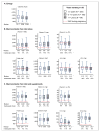The association of time in the US and diet during pregnancy in low-income women of Mexican descent
- PMID: 15787887
- PMCID: PMC3882002
- DOI: 10.1111/j.1365-3016.2005.00640.x
The association of time in the US and diet during pregnancy in low-income women of Mexican descent
Abstract
This study compared nutritional intake during pregnancy among women of Mexican descent according to country of birth (US vs. Mexico) and, for Mexico-born women, according to number of years lived in the US (<or=5 years, 6-10 years, >or= 11 years). A 72-item food frequency questionnaire (FFQ) was used to assess dietary intake in 474 pregnant Mexico-born immigrants and US-born Mexican-Americans. Mexico-born women had significantly higher intakes of calories (P = 0.02), fibre (P < 0.001), vitamin A (P < 0.001), vitamin C (P = 0.03), vitamin E (P < 0.01), folate (P < 0.01), calcium (P < 0.001) and zinc (P = 0.02) from their diets than US-born women. Intakes of all nutrients except vitamin C and zinc remained significantly higher in Mexico-born women when nutrients from both diet and vitamin supplements were considered. Among Mexico-born women, increasing years of residence in the US was associated with lower intake of calories (P(trend) < 0.01), fibre (P(trend) < 0.01), folate (P(trend) = 0.03), iron (P(trend) = 0.05) and zinc (P(trend) = 0.03), although only the trend for iron remained significant when vitamin supplement sources were included. A large percentage of women had inadequate intake of vitamin E (58%), folate (61%), iron (77%) and zinc (47%) from their diets during pregnancy and these rates were higher in US-born women than Mexico-born women.
Figures


Similar articles
-
Rankings of iron, vitamin D, and calcium intakes in relation to maternal characteristics of pregnant Canadian women.Appl Physiol Nutr Metab. 2016 Jul;41(7):749-57. doi: 10.1139/apnm-2015-0588. Epub 2016 Mar 11. Appl Physiol Nutr Metab. 2016. PMID: 27324651
-
Estimated intake and food sources of vitamin A, folate, vitamin C, vitamin E, calcium, iron, and zinc for Guamanian children aged 9 to 12.Pac Health Dialog. 2002 Sep;9(2):193-202. Pac Health Dialog. 2002. PMID: 14736100
-
Folate, vitamin D, and iron intakes are low among pregnant Finnish women.Eur J Clin Nutr. 1998 Oct;52(10):742-8. doi: 10.1038/sj.ejcn.1600638. Eur J Clin Nutr. 1998. PMID: 9805222
-
Influence of mineral and vitamin supplements on pregnancy outcome.Eur J Obstet Gynecol Reprod Biol. 2012 Oct;164(2):127-32. doi: 10.1016/j.ejogrb.2012.06.020. Epub 2012 Jul 6. Eur J Obstet Gynecol Reprod Biol. 2012. PMID: 22771225 Review.
-
Index of Nutritional Quality (INQ) and the Risk of Obesity in Male Adolescents: a Case-Control Study.Biol Trace Elem Res. 2021 May;199(5):1701-1706. doi: 10.1007/s12011-020-02297-3. Epub 2020 Sep 7. Biol Trace Elem Res. 2021. PMID: 32895892 Review.
Cited by
-
Associations between perinatal factors and adiponectin and leptin in 9-year-old Mexican-American children.Pediatr Obes. 2013 Dec;8(6):454-63. doi: 10.1111/j.2047-6310.2012.00127.x. Epub 2013 Jan 16. Pediatr Obes. 2013. PMID: 23325579 Free PMC article.
-
Food choices and practices during pregnancy of immigrant and Aboriginal women in Canada: a study protocol.BMC Pregnancy Childbirth. 2011 Dec 7;11:100. doi: 10.1186/1471-2393-11-100. BMC Pregnancy Childbirth. 2011. PMID: 22152052 Free PMC article.
-
Factors predicting organochlorine pesticide levels in pregnant Latina women living in a United States agricultural area.J Expo Sci Environ Epidemiol. 2007 Jul;17(4):388-99. doi: 10.1038/sj.jes.7500525. Epub 2006 Oct 11. J Expo Sci Environ Epidemiol. 2007. PMID: 17033681 Free PMC article.
-
Acculturation and serum nutrients thought to be involved with cancer prevention among Mexican American men in the United States.Cancer Control. 2009 Apr;16(2):169-75. doi: 10.1177/107327480901600209. Cancer Control. 2009. PMID: 19337203 Free PMC article.
-
An ethnographic investigation of the maternity healthcare experience of immigrants in rural and urban Alberta, Canada.BMC Pregnancy Childbirth. 2016 Jan 27;16:20. doi: 10.1186/s12884-015-0773-z. BMC Pregnancy Childbirth. 2016. PMID: 26818961 Free PMC article.
References
-
- Guzman B. The Hispanic Population: Census 2000 Brief. Washington, DC: U.S. Census Bureau; 2001. Report No.: C2KBR/01-3.
-
- U.S. Census Bureau. Profiles of General Demographic Characteristics: 2000 Census of Population and Housing: California. Washington, DC: U.S. Department of Commerce; 2001.
Publication types
MeSH terms
Substances
Grants and funding
LinkOut - more resources
Full Text Sources
Medical

